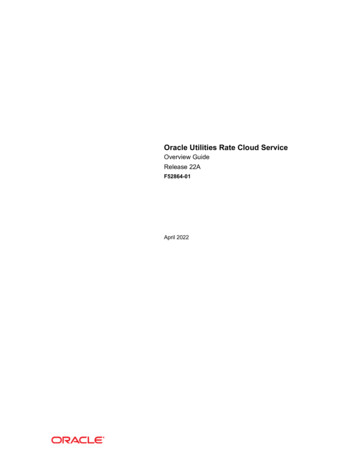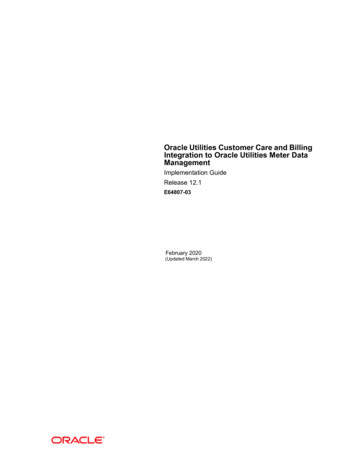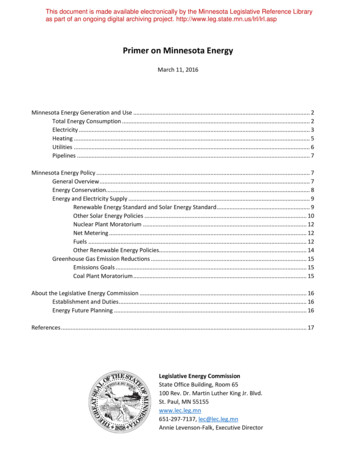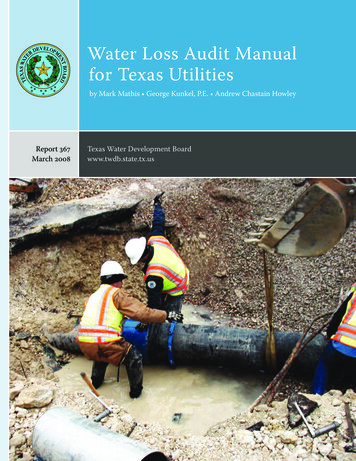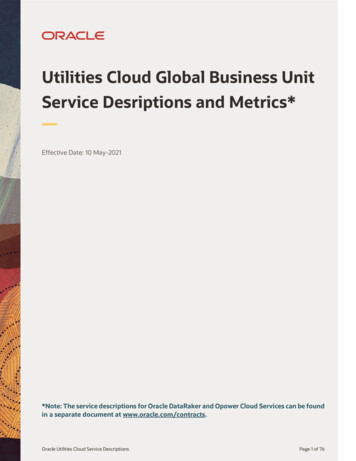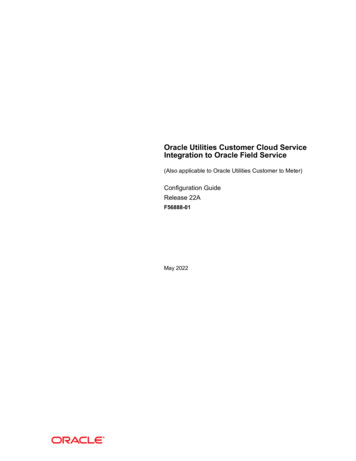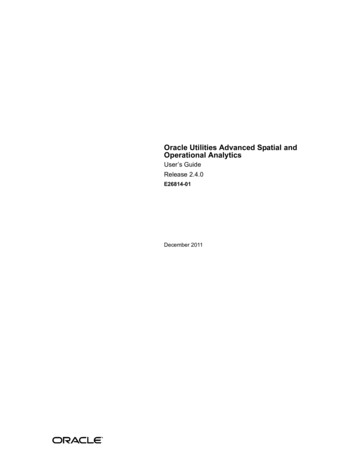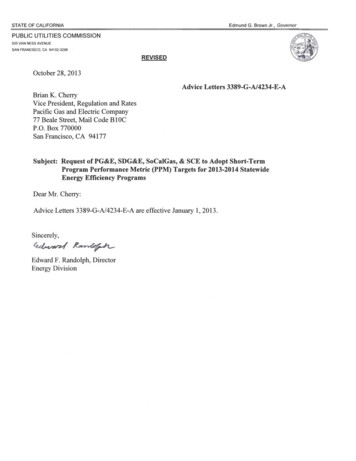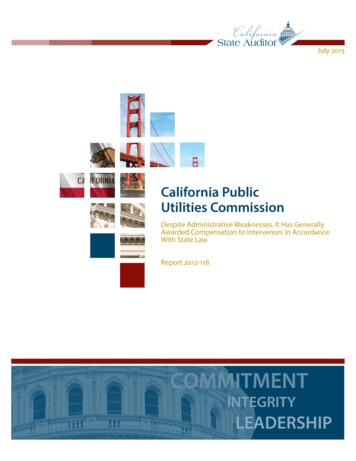
Transcription
July 2013California PublicUtilities CommissionDespite Administrative Weaknesses, It Has GenerallyAwarded Compensation to Intervenors in AccordanceWith State LawReport 2012-118COMMITMENTINTEGRITYLEADERSHIP
The first five copies of each California State Auditor report are free. Additional copies are 3 each, payable by checkor money order. You can obtain reports by contacting the California State Auditor’s Office at the following address:California State Auditor555 Capitol Mall, Suite 300Sacramento, California 95814916.445.0255 or TTY 916.445.0033ORThis report is also available on our Web site at www.auditor.ca.gov.The California State Auditor is pleased to announce the availability of an online subscription service.For information on how to subscribe, visit our Web site at www.auditor.ca.gov.Alternate format reports available upon request.Permission is granted to reproduce reports.For questions regarding the contents of this report,please contact Margarita Fernández, Chief of Public Affairs, at 916.445.0255.For complaints of state employee misconduct, contact the California State Auditor’sWhistleblower Hotline: 1.800.952.5665.
Elaine M. Howle State AuditorDoug Cordiner Chief DeputyJuly 23, 20132012‑118The Governor of CaliforniaPresident pro Tempore of the SenateSpeaker of the AssemblyState CapitolSacramento, California 95814Dear Governor and Legislative Leaders:As requested by the Joint Legislative Audit Committee, the California State Auditor (stateauditor) presents this audit report concerning the intervenor compensation program (program)administered by the California Public Utilities Commission (commission).This report concludes that despite administrative weaknesses, the commission has generallyawarded compensation to intervenors—individuals and groups that represent the interests ofutility ratepayers—in accordance with state law. We found that the commission has a processin place to ensure that intervenors meet the necessary statutory requirements before it awardscompensation for work conducted during regulatory proceedings. In addition, the commissionhas a robust process for determining whether the costs and expenses intervenors claim arereasonable, as state law requires. However, we determined that the commission only issued6 percent of its intervenor compensation decisions during 2008 through 2012 within the 75‑daydeadline required by state law. The commission has also not issued guidance to its staff orutilities on how to calculate interest appropriately for intervenor claim decisions issued afterthe 75-day deadline. The lack of formal guidance has led the commission to employ a flawedinterest computation methodology, resulting in miscalculations and, ultimately, overpaymentsof interest on awards. Of the 42,000 in interest that the commission paid for the 10 largestinterest payments we reviewed, we estimate that it overpaid 40,000.Further, we noted some areas in which the commission could do more to ensure that itappropriately compensates intervenors. Specifically, state law requires the commission to takeinto consideration the market rates paid to persons of comparable training and experience whooffer similar services. However, the commission has acknowledged it has faced difficulties infully complying with the requirement and that a comprehensive market rate study is necessaryto ensure compliance with the law. In addition, we found that the commission lacks formalprocedures to verify the qualifications of intervenors appearing in proceedings. Despite theseweaknesses, we found that the program fulfills a fundamental part of its purpose, which is toencourage the effective and efficient participation of all groups that have a stake in the publicutility regulation process. We found that organizations participating in the program representeda broad array of interests, including environmental concerns, low-income and minorityratepayers, and ratepayers in a specific geographic region.Respectfully submitted,ELAINE M. HOWLE, CPAState Auditor555 Capitol Mall, Suite 300S a c r a m e n t o, C A 9 5 8 1 4916.445.0255916.327.0019 faxw w w. a u d i t o r. c a . g o v
Blank page inserted for reproduction purposes only.
California State Auditor Report 2012-118July 2013ContentsSummary1Introduction5Audit ResultsThe Commission Has a Robust Process for ReviewingCompensation Claims15The Commission Has Not Promptly Compensated Intervenorsand Has Overpaid Interest22The Commission Could Do More to Ensure CompensationIs Appropriate26Intervenors Have Mixed Views on the Quality of theCommission’s Guidance31The Program Has Allowed a Variety of Interests toHave a Voice in Proceedings33Recommendations35AppendixAward and Financial Information Related to 10 Intervenors37Response to the AuditCalifornia Public Utilities Commission43v
viCalifornia State Auditor Report 2012-118July 2013Blank page inserted for reproduction purposes only.
California State Auditor Report 2012-118July 2013SummaryResults in BriefThe California Public Utilities Commission (commission) isresponsible for ensuring that California utility customers havesafe, reliable utility service at reasonable rates, protecting utilitycustomers from fraud, and promoting the health of California’seconomy. The commission’s intervenor compensation program(program) is intended to ensure that intervenors—individualsand groups that represent the interests of utility ratepayers—have the financial resources to bring their concerns andinterests to the commission at its proceedings. Intervenorsadvocate for a variety of ratepayers, including residential andsmall‑business customers, minority groups, and the disabled.The commission awarded 25.5 million from 2008 through 2012for 337 claims intervenors submitted. The commission awardedthe majority of that compensation to a relatively small group ofintervenors: 10 intervenors received 84 percent of the amountawarded during that time.We found that the commission has a process in place to ensure thatintervenors meet the necessary statutory requirements before itawards them compensation for work conducted during regulatoryproceedings. Moreover, administrative law judges and programanalysts (commission staff ) generally ensured that intervenors metthose requirements before the commission issued awards in the20 compensation decisions we reviewed from 2008 through 2012.Specifically, as the law requires, commission staff consistentlydetermined whether intervenors had demonstrated significantfinancial hardship. They also established that intervenors wereutility customers or represented customers. Finally, before thecommission awarded compensation to the intervenors, commissionstaff verified that the intervenors had substantially contributed tothe proceedings.In addition, the commission has a robust process for determiningwhether the costs and expenses intervenors claim are reasonable, asstate law requires. Specifically, the commission requires intervenorsto submit detailed time logs and other documentation to supporttheir requests for compensation for the hours their staff worked andfor travel expenses and other costs. The commission uses a deskreview process that adjusts claims for inefficient work and excessivehours spent on certain activities. In our review of 20 compensationdecisions, we found that the commission staff responsible for thoseadjustments reduced awards for a number of reasons, includinginappropriately high hourly rates, excessive staff hours claimed, andlack of substantial contribution to the proceeding.Audit Highlights . . .Our review of the California Public UtilitiesCommission’s (commission) intervenorcompensation program (program), revealedthat the commission:»» Generally ensured that intervenors—individuals and groups that representthe interests of utility ratepayers—metstatutory requirements before itissued awards.»» Requires and reviews detailed time logsand other documentation to supportintervenors’ requests for compensationand adjusts claims for inefficient work andexcessive hours spent on certain activities.»» Awarded only 6 percent of the claimssubmitted during 2008 through 2012for intervenor compensation within therequired 75-day time frame—it wasmore than six months late for 30 percentof the claims awarded during that period.»» Does not have formal guidance on howto calculate interest appropriately forintervenor claim decisions issued afterthe 75-day deadline resulting in 40,000in estimated overpayments of intereston awards.»» May be inappropriately compensatingintervenors until it establishes marketrates that comply with state law.»» Lacks any formal procedures for verifyingthe qualifications of intervenorsappearing in proceedings and did nothave evidence that its analysts hadverified qualifications in the past.1
2California State Auditor Report 2012-118July 2013However, the commission did not issue most decisions awardingintervenor compensation in a timely manner during 2008through 2012. Our review revealed that the commission regularlyexceeded the 75‑day deadline that state law imposes for awardingintervenor compensation. We found that the commission awardedfunds within that required time frame for only 20 (or 6 percent)of the claims submitted during our five‑year audit period. In fact,101 (or 30 percent) of the payment decisions that occurred duringthe period were awarded more than six months late. However, thecommission has never conducted any analysis to determine whatis leading to the delays. Although commission staff were able toprovide some reasons for delays, they do not track submittedclaims in sufficient detail to identify where in the process thesedelays are occurring. Further, the frequency of the delays mightdiscourage some intervenors from participating in the program. Inaddition, we estimated that delays in awarding compensation forthe 20 decisions we reviewed resulted in approximately 34,000in interest for those awards. Ratepayers ultimately paid thisadditional cost.The commission has also not issued guidance to its staff or utilitieson how to calculate interest appropriately for intervenor claimdecisions issued after the 75‑day deadline. Although the utilitiestypically calculate interest and pay it along with the awardedamount, the commission does so as well for a small subset ofawards using funds from ratepayer fees that utilities collectstatewide. The lack of formal guidance has led the commissionto employ a flawed interest computation methodology, resultingin miscalculations and, ultimately, overpayments of interest onawards. For example, on one 318,000 award, the accountingstaff calculated 22,100 in additional interest by incorrectlydetermining the daily rate at which interest accrued on the award,among other errors. However, if the accounting staff had correctlycalculated the amount of daily accrued interest, we estimate thatthe commission would have paid only 560. Commission recordsindicated that its accounting staff computed interest for 18 awardsfrom March 2010 to May 2013, the period for which records wereavailable. In reviewing 42,000 that commission records indicatedit paid for the 10 largest interest payments, we estimate that thecommission overpaid 40,000 in interest. If the commission hadissued guidance to its accounting staff, these overpayments mighthave been prevented. Once we brought this issue to their attention,commission staff began developing guidance for internal use andfor distribution to utilities.In general the commission’s compensation to intervenors hascomplied with state law for the 20 decisions we reviewed.However, we noted some areas in which the commission coulddo more to ensure that it appropriately compensates intervenors.
California State Auditor Report 2012-118July 2013Specifically, state law requires the commission to take intoconsideration the market rates paid to persons of comparabletraining and experience who offer similar services. A 2012commission resolution indicated that the commission historicallyconsidered each request for an hourly rate individually,one proceeding at a time, until it completed a market rate studyin 2005 (2005 study). Since then, the commission used an annualupdate process to adjust the hourly market rates it awards tointervenors. However, the commission has acknowledged it hasfaced difficulties in fully complying with the requirement andindicated that a comprehensive market rate study is necessary toensure compliance with the law. For example, the commissionfound that the 2005 study contained insufficient data to captureall of the possible market rate ranges. To address this issue, thecommission plans to hold another public workshop to discussthe updating process for hourly rate ranges, benchmark studies, andcost‑of‑living adjustments for 2014 and later years. However, untilthe commission establishes market rates that comply with state law,it may be inappropriately compensating intervenors.Moreover, although program analysts (analysts) claimed that theyhad informal procedures to verify the qualifications of intervenorsappearing in proceedings, the commission lacks any formalprocedures for doing so and was unable to demonstrate thatits analysts had performed such verifications in the past. A formeranalyst stated that in 2010 she began to verify qualifications bychecking the California State Bar Web site for the membershipstatus of each attorney appearing before the commission for thefirst time. Current analysts stated that, as of January 2013, they alsocall previous employers of each attorney or expert to ensure thateach intervenor staff member has the experience he or she claimswhen participating in a regulatory proceeding for the first time.However, no formal guidance or procedures instruct the analyststo verify such qualifications, and the analysts could not provide anydocumentation showing that they had performed such verificationson past claims. The intervenor compensation program coordinatorstated that, as of June 2013, the commission was in the process ofdrafting procedures to address this issue. However until those newprocedures are in place, future analysts could omit the verificationprocess from their review of claims, resulting in overcompensationto intervenors who may have overstated their qualifications.Finally, in our review of the 20 compensation decisions, wefound that the program fulfills a fundamental part of its purposedespite some administrative weaknesses. The Legislaturehas declared its intent that the program be administered in amanner that encourages the effective and efficient participationof all groups that have a stake in the public utility regulationprocess. A 1998 commission decision that made revisions to the3
4California State Auditor Report 2012-118July 2013program acknowledged the importance of receiving input from asocioeconomically, culturally, and geographically diverse public,and that decision indicated that one purpose of the program wasto reduce barriers to participation such customers sometimesface. In our review of the 15 regulatory proceedings representedin the 20 compensation decisions, we found that organizationsparticipating in the program represented a broad array of interests,including environmental concerns, low‑income and minorityratepayers, and ratepayers in a specific geographic region, and manyof these requested compensation for their contributions.RecommendationsThe commission should determine the cause of its lack ofcompliance with state law requiring it to issue award decisionswithin 75 days of the date an intervenor submits a compensationclaim, and it should determine what actions to take to rectify theproblem. The commission should ensure that it has sufficientinformation, such as detailed tracking information regardingclaims, to identify where in the process delays are occurring. If thecommission determines that the current 75‑day statutory period isunreasonable, it should seek a change in state law.To ensure that utilities and commission staff pay the correctamount of interest to intervenors, the commission should completeits effort to develop and distribute a methodology for calculatingreasonable interest on award decisions issued after the 75‑daydeadline. The commission should follow the new procedure toensure that it calculates interest payments appropriately. To theextent reasonable, the commission should recoup the interestoverpaid to intervenors.To comply fully with state law, the commission should conduct acomprehensive market rate study and update it periodically.Commission staff should complete their effort to develop formalprocedures to verify and document the qualifications of intervenors’attorneys and experts. The commission should implement the newprocedures to ensure that it awards intervenors an appropriatehourly rate based on verified qualifications.Agency CommentsThe commission agreed with our recommendations andoutlined the steps it has taken or plans to take toimplement them.
California State Auditor Report 2012-118July 2013IntroductionBackgroundThe California Public Utilities Commission (commission), whichconsists of five members appointed by the governor and approvedby the Senate, is responsible for ensuring that California utilitycustomers have safe, reliable utility service at reasonable rates, forprotecting utility customers from fraud, and for promoting thehealth of California’s economy. State law authorizes the commissionto establish its own procedures for hearings and proceedings. Thecommission has broad constitutional and statutory powers toregulate investor‑owned electric, natural gas, telecommunications,and water utilities, as well as railroad and passengertransportation companies.The commission initiated its intervenorcompensation program (program) in1981, and state law was enacted to governthe program effective January 1985. Accordingto the commission’s program guide, the programis intended to ensure that intervenors—individualsand groups that represent the interests of utilityratepayers—have the financial resources to bringtheir concerns and interests to the commission at itsproceedings. Intervenors advocate for a variety ofratepayers, including residential and small‑businesscustomers, minority groups, and the disabled. Byhearing different perspectives, the commissionis better able to make informed decisions thatconsider the impact of utility costs and serviceson all Californians. As shown in the text box, theprogram has several goals, such as encouragingparticipation of all groups that have a stake in theregulation process.Goals and Intent of the IntervenorCompensation Program To encourage the effective and efficient participationof all groups that have a stake in the public utilityregulation process. To avoid unproductive or unnecessary participation thatduplicates the participation of similar interests otherwiseadequately represented. To provide compensation to intervenors for reasonableadvocate fees, reasonable expert witness fees, and otherreasonable costs of participation in commission andrelated proceedings. To award compensation to eligible intervenors withina reasonable period after the intervenor has made asubstantial contribution to a proceeding.Source: California Public Utilities Code, sections 1801, 1801.3,and 1802.State law allows intervenors that participate incommission proceedings involving utilities, such as electric, gas,and water utilities, to request compensation for the costs associatedwith that participation. Public utilities generally pay theseintervenor compensation awards from the amounts they collectfrom their ratepayers. These awards affect utility rates becausestate law requires the commission to adjust utility rates so thatutilities can recoup any amounts they pay to intervenors. Typically,only a specific utility subject to the proceeding is responsible forpaying the related intervenor compensation, and it subsequentlyincreases its rate to cover the award amount. If a proceeding applies5
6California State Auditor Report 2012-118July 2013to a utility category, such as all energy utilities, the commissionpays the award with funds from ratepayer fees that utilities collectthroughout the State.Commission compensation decisions suggest that intervenorparticipation in commission proceedings can substantially benefitratepayers. For example, one compensation decision indicated thatan intervenor’s participation in a proceeding to set a utility’s ratesbenefited ratepayers by an estimated 354 million. The commission’scompensation decision indicated that the intervenor raised morethan 60 issues throughout the proceeding, and it awarded theintervenor 784,000 for its work. In another case, the compensationdecision stated that an intervenor’s work on a different utility’srate‑setting proceeding resulted in approximately 130 million insavings to ratepayers, and the commission awarded the intervenor 586,000 in compensation. This intervenor engaged withtwo consulting groups whose work resulted in expert findings thatcontributed to the recognized savings attributable to the intervenor.The Program’s Award ProcessAs shown in Figure 1, an intervenor planning to claim intervenorcompensation must get involved in the process early. The intervenormust file a notice of intent to claim compensation that indicatesto the commission the planned extent and estimated costs of theintervenor’s planned participation in a proceeding. In addition,to be eligible for compensation, the intervenor must show that itmeets various mandates that state law imposes, as we discuss below.When the commission issues a final decision on a proceeding, theintervenor may file a claim for intervenor compensation within60 days. Once the claim is filed, the commission is required to issuea compensation decision on it within 75 days.State law requires that before being awarded compensation,intervenors must demonstrate that they made a substantialcontribution to the commission proceeding. Specifically, eachintervenor must substantially assist the commission in the makingof its order or proceeding decision based on factual contentions,legal arguments, or policy recommendations. For instance, in oneproceeding, the commission’s compensation decision indicatedthat an intervenor submitted testimony from multiple witnesseson issues related to the utility’s electric and gas distribution andelectric generation functions. In addition, the intervenor broughtup additional issues when it cross‑examined the utility’s witnessesduring evidentiary hearings. After the conclusion of the evidentiaryhearings, the intervenor worked with other intervenors in theproceeding to achieve a settlement on a number of issues that thecommission generally adopted.
California State Auditor Report 2012-1187July 2013Figure 1Major Components of the Intervenor Compensation Award ProcessProceeding initiatedA proceeding may beinitiated by theCalifornia PublicUtilities Commission(commission); aregulated entity,such as a utility; ora complainant.Intervenor files claimfor compensationAn intervenor may file aclaim for compensationwithin 60 days after thecommission issues afinal decision.Proceeding assigned to anadministrative lawjudge (judge) anda commissionerJudge and commissionerresponsibilities depend onthe proceeding type.*Commission issuesfinal decisionon proceedingIntervenor filesnotice of intent (NOI)to claim intervenorcompensationUsually filed early inthe proceeding.The assigned judge issuesa ruling on the NOI if:† The NOI is deficient; The judge desires to addressmatters that may affectthe customer's intervenorcompensation claim; or The NOI includes a claimof significant financialhardship that requiresa finding.Proposed decisionon proceedingHearings are heldPrepared by the assignedjudge or commissionerdepending on the typeof proceeding.Information is gatheredfrom the parties involvedabout the proceeding'srelevant issues.CLAIM AMOUNT ISJudge reviewsthe claimJudge determines whetherthe intervenor made asubstantial contribution tothe proceeding's outcomeand, in conjunction withan analyst, undertakesa detailed review ofthe claim.Proposed decisionon intervenorcompensation claimPrepared by the assignedjudge and distributed tocommissioners. Also madeavailable on thecommission’s Web site.Thirty-daypublic comment periodIntervenors and other partiesmay file comments on theproposed compensationdecision. The commissionnormally waives the 30-daycomment period unlessit sizably reduces theamount claimed.Commission issuesfinal decisionon intervenorcompensation claimState law requires thecommission to issue adecision within 75 daysafter the filing of a requestfor compensation.Awarded in fullorModifiedorDeniedSources: Commission staff and documents and California Public Utilities Code, sections 1801 through 1812.* Proceeding types include adjudicatory proceedings (typically policy or rule enforcement), rate‑setting proceedings (generally policy interpretationor proceedings setting rates), and quasi‑legislative proceedings (generally policy development).† If the assigned judge does not issue a ruling on the intervenor’s NOI, the process continues to the hearing phase.However, the commission does not have to adopt an intervenor’sposition to find that the intervenor made a substantial contributionto a proceeding. For instance, in one intervenor compensationdecision, the commission stated that although it rejected theintervenor’s argument on an issue, the intervenor contributed tothe issue by providing a unique point of view that enriched thecommission’s deliberations. The commission also did not adoptthat intervenor’s recommendation on another issue in the sameproceeding, but the commission stated that the intervenor providedrelevant arguments and that its recommendations representeda legitimate approach and contributed to the commission’sconsideration of the issue.In addition, state law requires that the intervenor must show“significant financial hardship” to receive compensation, bysubmitting documents demonstrating either that the intervenor
8California State Auditor Report 2012-118July 2013could not afford to participate without undue hardship or—inthe case of a group or an organization—that the economicinterest of the individual members is small in comparison to thecost of effective participation in the proceeding. In the latterinstance, this allows intervenors to represent different groupsof customers that would not find it economically advantageousto represent themselves individually when compared to the costof participating in the process. In addition to demonstratingsignificant financial hardship, the intervenor must meet othermandates, such as submitting documents within a prescribedtime frame.The program is currently managed by an assistant chiefadministrative law judge (assistant chief judge), who alsoacts as the intervenor compensation program coordinator(program coordinator). The program coordinator, who directedtwo program analysts (analysts) at the time of our review, isresponsible for the proper distribution of claims‑related work tothese analysts, who review the claims and, in collaboration withthe assigned administrative law judge (judge), draft proposeddecisions on compensation awards. The chief administrative lawjudge, an assistant chief judge, and the assigned commissionerthen review the proposed decision prior to it being brought beforethe commission for consideration.Intervenors can challenge the commission’s compensationdecisions. When the commission proposes a sizable reduction inthe amount of intervenor compensation requested, an intervenorhas an opportunity to make comments on the proposed decisionfor the commission to consider before it issues its final award.After the commission has issued a final compensation decision,an intervenor can petition the commission for a modification tothat award to correct a factual error. If the intervenor believesthe commission made a legal error in the decision, the intervenorcan file a request for a rehearing. The purpose of an applicationfor a rehearing is to alert the commission to a legal error, so thatthe commission may correct it. Following the rehearing, or if thecommission denies an application for a rehearing, the intervenormay petition for a writ of review in the court of appeal or theCalifornia Supreme Court.As shown in Table 1, the commission awarded 25.5 millionduring the five‑year period from 2008 through 2012 for 337claims intervenors submitted. The commission denied six claimsin full, and it awarded less than the amount claimed 80 percentof the time, representing a 4.9 million reduction of the totalamount claimed.
California State Auditor Report 2012-118July 2013Table 1Intervenor Compensation Claim Decisions Made by the CaliforniaPublic Utilities Commission2008 Through 2012CLAIMDECISIONSMADEAwarded in fullDeniedModified*Totals62PERCENTAGEOF TOTALDECISIONSAMOUNTCLAIMED(IN MILLIONS)AMOUNTAWARDED(IN MILLIONS)PERCENTAGE OFTOTAL AMOUNTAWARDED18% 2.0 2.08%620.30.002698028.123.592337100% 30.4 25.5100%Source: California Public Utilities Commission (commission) intervenor compensationprogram decisions.* All modified awards were for less than the amount claimed by intervenors in their compensationrequests, unless the commission corrected for mathematical errors after the claim was submitted.The commission awarded the majority of that compensation toa relatively small group of intervenors. As shown in Table 2 onthe following page, 10 intervenors accounted for 84 percent of theamount awarded in the last five years. For more information aboutthose 10 intervenors, see the Appendix.The Role of the Division of Ratepayer AdvocatesThe role of the Division of Ratepayer Advocates (division) is similarto that of intervenors in that the division represents ratepayers incommission regulatory proceedings. According to state law, thedivision is tasked with representing and advocating on behalf of
in interest for those awards. Ratepayers ultimately paid this additional cost. The commission has also not issued guidance to its staff or utilities on how to calculate interest appropriately for intervenor claim decisions issued after the 75‑day deadline. Although the utilities typically calculate interest and pay it along with the awarded
